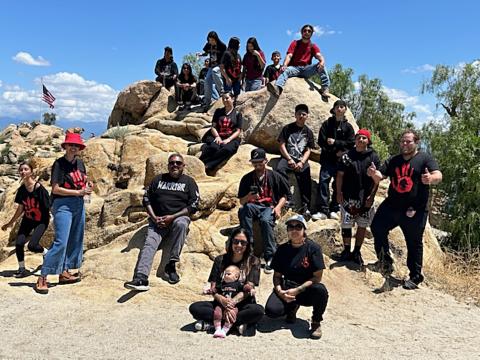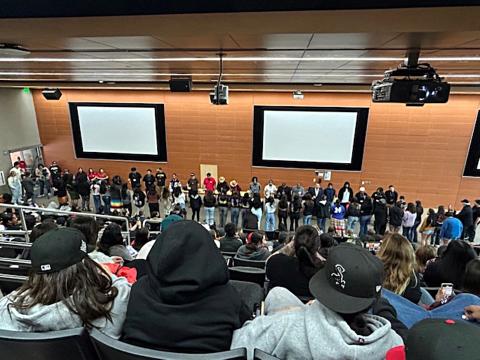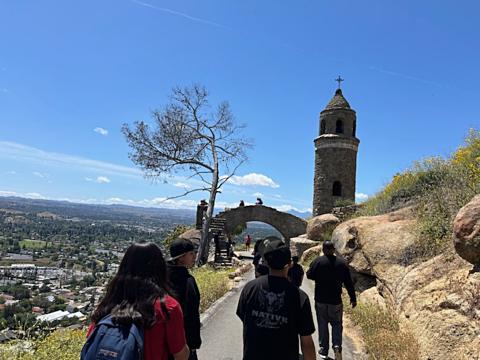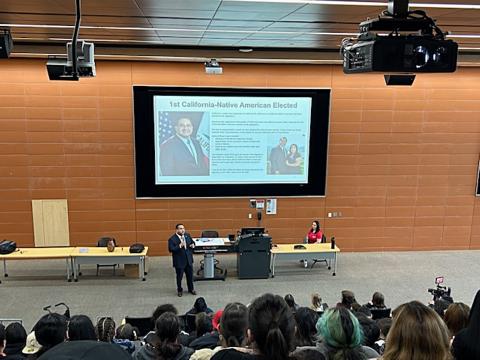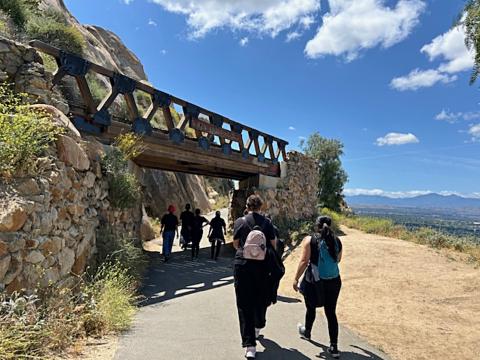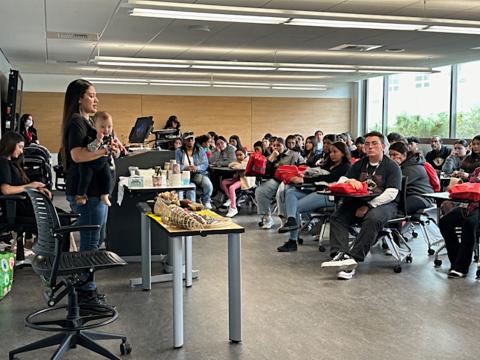In recent weeks, young members of the Soboba TANF Program have participated in two events that taught them about local history as well as what they can expect in the future. On April 27, 34 Native youth attended the Dream the Impossible Native Youth Conference, accompanied by eight adults. On May 5, they were treated to a special screening of a documentary about Mt. Rubidoux, followed by a hike up the mountain trail.
Held this year at San Diego State University, DTI’s mission is to challenge Native youth to D.R.E.A.M., which is an acronym for Dedication, Responsibility, Education, Attitude, Motivation. The youth conference was started in 2007 by several Southern California Tribes and Tribal organizations. The dream began when local youth councils planned to organize a conference specifically for Southern California Native youth. After several planning meetings, the youth voted on a conference name and agreed to host the first ever Southern California Native Youth Conference on the Soboba Indian Reservation at Noli Indian School and the Sports Complex. The success of this conference marked the beginning of the Dream the Impossible Youth Conference becoming an annual event. Today there are more than 35 Tribes, Tribal organizations, and universities that contribute to the DTI Youth Conference.
Soboba Tribal TANF Program Regional Prevention Manager Harold Arres said he enjoyed listening to keynote speaker Assemblymember James Ramos, who talked about the resiliency of the Native people. Program Specialist Mayra Campos said a highlight to her was the number of youths that gathered for the event.
“This was my first year attending and I was amazed at all the different groups that attended from various areas. Everyone came together to participate and enjoy the event,” she said.
Ten breakout sessions were repeated throughout the day to provide students with the opportunity to attend three of their choosing. A variety of subjects were covered, including MMA is Not Just a Sport; Culture, Tribal Law, & Our Community Values; Stay Rooted in Indigenous Culture through Farming; and The Future of Native Filmmaking.
TANF member Reese Elliott, 16, learned about the difference between Western law and Indian Country law in a session facilitated by Dwight K. Lomayesva, Executive Director and co-founder of the American Indian Recruitment (AIR) programs that focus on serving underprivileged American Indians in education.
“My favorite part was being able to spend time with my friends and family and the Men’s Fancy and other dances,” said Reese, who also attended the filmmaking and Native Foods sessions. “What impressed me the most (about the SDSU campus) was the architectural design of the buildings. It really fascinated me.”
Zachary Guacheno also attended the Native Foods and Tribal Law sessions and learned that many college campuses have programs designed for Native American students. He also enjoyed the session on MMA, hosted by Eddie and the Native Youth Foundation. They explained how MMA offers a unique blend of physical, mental and emotional benefits such as boosting confidence and reducing stress.
“I was impressed with how big the campus is and I like how it’s close to the beach,” Zachary, 17, said. He also enjoyed the organized cultural activities, games and College Fair offered during the lunch break from 12:30 to 2 p.m.
Andrew Velazquez attended sessions that taught him more about filmmaking, tribal law and Native foods. The latter was presented by Blossom Maciel who has been teaching the art of traditional basketweaving and Native plant use for the past 19 years. She is committed to learning, teaching and passing on her rich cultural heritage to her family and community.
Andrew said he learned much about moviemaking by attending “The Future of Native Filmmaking” presented by Vision Maker Media, whose mission is empowering and engaging Native people to share stories. VMM introduced participants to the power of storytelling and filmmaking for Native communities. Andrew hopes to use the knowledge he gained in the future. “My favorite part was that we had multiple and actual movie supplies in front of us,” the 16-year-old said.
After the all-day conference, the group headed back home. For more information, please visit https://dticonference.org.
Campos said, “I hope the kids were able to accept the overall message of the conference. DTI is all about believing in yourself and aspiring to do great things. It is important for the Native youth to have confidence and self-love in order to dream big.”
Arres added, “I hope that the youth learned that anything is attainable in life.”
On May 5, TANF members were invited to an exclusive screening of the documentary “Pá’Čapa: A Mt. Rubidoux Story” at the Soboba Tribal TANF center in Riverside. It was presented by the film’s creators and co-directors Blossom Maciel and Rosy Aranda.
Pá’Čapa is Cahuilla for “where the water bends,” which can be seen along the three-mile recreational trail that looks down on the bending Santa Ana River. The site attracts upward of 1,000 visitors a day. Monuments and plaques on the mountain focus on colonial history. Through community engagement with Tribal communities, this documentary seeks to present the voices of cultural bearers to highlight how this is a sacred Native place.
Aranda and Maciel introduced the film by telling the youth a little about the process of how it came to be. “We encouraged them to continue to visit Pá'Čapa because it is a place where our ancestors were,” Aranda said.
Soboba’s Kimani Sanchez, 15, said from the film she learned that some roads that we drive on were once used by Native Americans to do trades.
After the screening, the group hiked Mt. Rubidoux, joined by the filmmakers. Aranda said it was a great feeling having the youth up there.
This was Kimani’s first visit to the mountain and she said there was a lot to see and it was beautiful. “The best part was making it to the top and being able to see little animals and an amazing view,” she said. “I plan to share the information I learned with my parents and my cousins who were not able to go on the hike.”
Anthony Salgado, 18, is from the Cahuilla Band of Indians and was surprised to learn that the people from Pá'Čapa were mountain Cahuilla. “Climbing was the best part,” he said about making his first hike there.
Kevin Estanislao from Soboba discovered from the film that Native Americans were the first residents of Riverside and plans to share all he learned with his friends. “I liked the scenery,” the 14-year-old said about the hike. “The best part was climbing the steps to the cross.”
May 5 was also the National Day of Awareness for Missing and Murdered Indigenous Women. “It was a beautiful day for us to do that ‘walk of reverence’ on MMIW day. We all had shirts with the red handprint as we made our way to the summit,” Aranda said. “Stopping to discuss different parts of the mountain like the dynamite explosions in the rocks and seeing Big Spring Rancheria from above were a few highlights.”
The next opportunity for the public to view “Pá’Čapa: A Mt. Rubidoux Story” will be Saturday, June 15 from 10 a.m. to 2 p.m. when it will be playing on a loop at the Ya’i Heki’ Regional Indian Museum at Lake Perris, 17801 Lake Perris Dr. in Perris.
“We feel there is a need to share this documentary locally so concentrating on schools, colleges, universities and museums in the surrounding area is our focus. We have had a positive response from everyone who has seen it; the support has been humbling,” Aranda said. “We know how important this piece of Riverside history is and spreading awareness is the start of a conversation that helps bring change.”
For more information, please email abbyroro63@yahoo.com and blossom_maciel@yahoo.com or visit Instagram at @pa.capa documentary, @earthyblossom, @nichil.rosy and @motherearthclan.
Photos courtesy of the Soboba Band of Luiseño Indians


